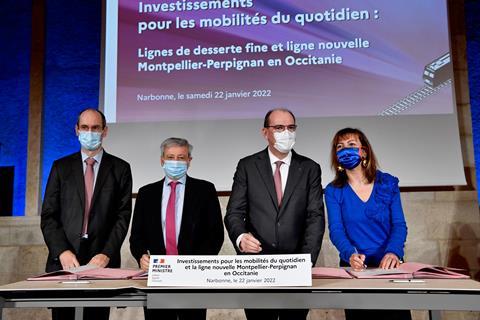
FRANCE: A memorandum of understanding covering the financing of construction of the first phase of the LGV Montpellier-Perpignan mixed-traffic high speed line was signed in Narbonne on January 22 in the presence of Prime Minister Jean Castex. Under the MoU, the Occitanie region and 10 other local authorities will contribute €816m to the project.
These local bodies are due to contribute 40% of the €2bn cost, with the state contributing another 40% and the European Commission funding the remaining 20%. Occitanie itself will contribute nearly €335m.
Totalling 150 route-km, LGV Montpellier-Perpignan is seen as the missing link between the French and Spanish high speed networks. Forming an extension to the existing Contournement Nîmes-Montpellier bypass, the line would be routed to the south of Béziers and north of Narbonne, meeting the existing 1 435 mm gauge railway across the border to Figueres in Spain at Perpignan, opened in 2010. It would cut journey times between Paris and Perpignan from 5 h 10 min currently to 4 h 20 min. It is expected to cost around €6bn to complete, and will be designed and passenger services running at up to 320 km/h.
The high speed line is to be developed in two stages: the first section from Montpellier to Béziers, totalling 52·3 km, will be designed to handle freight traffic, and the second, covering 97·7 km, will include two new stations but will be used solely by passengers trains.
A public inquiry process will now get underway, with preliminary work on the first section expected to be given the go-ahead under a Déclaration d’Utilité Public by July 27 2023. Construction should then begin by early 2030, and the first section is expected to begin operating around 2034. Construction of the second section would follow around 2040.
- On the same date, the national government and the Occitanie region signed another MoU agreeing funding for the modernisation of 15 secondary lines worth up to €1·6bn; the region would provide €800m.

















